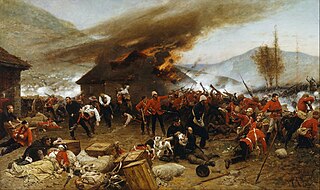
The Battle of Rorke's Drift, also known as the Defence of Rorke's Drift, was an engagement in the Anglo-Zulu War. The successful British defence of the mission station of Rorke's Drift, under the command of Lieutenants John Chard of the Royal Engineers and Gonville Bromhead, of the 24th Regiment of Foot began once a large contingent of Zulu warriors broke off from the main force during the final hour of the British defeat at the day-long Battle of Isandlwana on 22 January 1879, diverting 6 miles (9.7 km) to attack Rorke's Drift later that day and continuing into the following day.

The Anglo-Zulu War was fought in 1879 between the British Empire and the Zulu Kingdom. With the most famous battle being the Defense of Rorkes Drift.
Following the passing of the British North America Act of 1867 forming a federation in Canada, Lord Carnarvon thought that a similar political effort, coupled with military campaigns, might lead to a ruling white minority over a black majority, which would provide a large pool of cheap labour for the British sugar plantations and mines, encompassing the African Kingdoms, tribal areas and Boer republics into South Africa. In 1874, Sir Bartle Frere was sent to South Africa as High Commissioner for the British Empire to effect such plans. Among the obstacles were the armed independent states of the South African Republic and the Kingdom of Zululand.

The Battle of Isandlwana on 22 January 1879 was the first major encounter in the Anglo-Zulu War between the British Empire and the Zulu Kingdom. Eleven days after the British invaded Zululand in Southern Africa, a Zulu force of some 20,000 warriors attacked a portion of the British main column consisting of approximately 1,800 British, colonial and native troops with approximately 350 civilians. The Zulus were equipped mainly with the traditional assegai iron spears and cow-hide shields, but also had a number of muskets and antiquated rifles.

Lieutenant-Colonel Anthony William Durnford was an Irish career British Army officer of the Royal Engineers who served in the Anglo-Zulu War. Breveted colonel, Durnford is mainly known for his defeat by the Zulus at the Battle of Isandlwana, which was a disaster for the British Army.

Colonel John Rouse Merriott Chard was a British Army officer who received the Victoria Cross, the highest military decoration for valour "in the face of the enemy" that can be awarded to members of the British armed forces. He earned the decoration for his role in the defence of Rorke's Drift in January 1879 where he assumed command of the outpost and a small garrison of 139 soldiers and successfully repulsed an assault by some 3,000 to 4,000 Zulu warriors. The battle was recreated in the film Zulu in which Chard was portrayed by Stanley Baker.
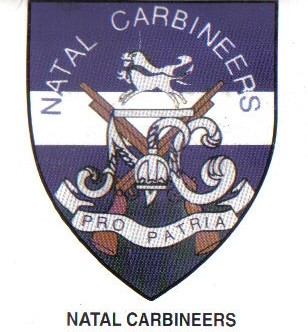
The Ingobamakhosi Carbineers is an infantry unit of the South African Army.

The Johannesburg Light Horse Regiment, is a reserve armoured car reconnaissance unit of the South African Army.

The Queen Nandi Mounted Rifles is an reserve armoured regiment of the South African Army.

The Umvoti Mounted Rifles is an armoured regiment of the South African Army. As a reserve unit, it has a status roughly equivalent to that of a British Army Reserve or United States Army National Guard unit. It is part of the South African Army Armour Formation and is based in the town of Pinetown.
Lieutenant-Colonel Henry Burmester Pulleine was an administrator and commander in the British Army in the Cape Frontier and Anglo-Zulu Wars. He is most notable as a commander of British forces at the disastrous Battle of Isandlwana in January 1879. Substantively a major, he held the rank of brevet lieutenant colonel.

The Natal Native Contingent was a large force of auxiliary soldiers in British South Africa, forming a substantial portion of the defence forces of the British colony of Natal. The Contingent saw action during the 1879 Anglo-Zulu War. The Natal Mounted Police was created in 1873 to bolster the defenses of Natal. It enlisted European officers, NCOs and natives. The infantry was created in 1878. Most enlisted troops were drawn from the Basuto and Mpondo tribes, which had had long experience fighting the Zulus.

Major General Sir Harcourt Mortimer Bengough joined the British Army in 1855, and retired in 1899, after more than forty years of distinguished service from the Crimea to all quarters of the Empire.
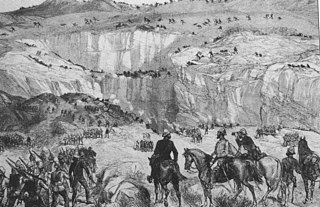
The 12 January 1879 action at Sihayo's Kraal was an early skirmish in the Anglo-Zulu War. The day after launching an invasion of Zululand, the British Lieutenant-General Lord Chelmsford led a reconnaissance in force against the kraal of Zulu Chief Sihayo kaXongo. This was intended to secure his left flank for an advance on the Zulu capital at Ulundi and as retribution against Sihayo for the incursion of his sons into the neighbouring British Colony of Natal.
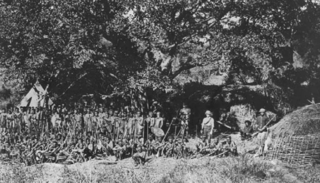
The Natal Border Guard was an auxiliary force levied for the defence of the Colony of Natal during the Anglo-Zulu War of 1879. British military commander Lord Chelmsford had intended to raise a large auxiliary force to support his invasion of the Zulu Kingdom but was opposed by the civilian government of the Colony of Natal, led by its governor Henry Ernest Gascoyne Bulwer, who would have to finance the unit. Bulwer eventually allowed a smaller force to be raised with the stipulation that it not be deployed outside of Natal. This unit was to serve only on a part-time basis, receive no training and fight with the traditional weapons of spear and shield.

The Natal Native Pioneer Corps, commonly referred to as the Natal Pioneers, was a British unit of the Zulu War. Raised in November/December 1878 the unit served throughout the war of 1879 to provide engineering support to the British invasion of Zululand. Three companies were formed each comprising around 100 men and clad in old British Army uniforms. The units served at the battles of Isandlwana, Eshowe and Ulundi.
Gert Wilhelm Adendorff was a member of the Natal Native Contingent notable for being the only soldier on the British side present at both the Battle of Isandlwana and the Battle of Rorke's Drift during the Anglo-Zulu War of 1879 made memorable in the film Zulu (1964).

Major-General Sir John George Dartnell KCB, CMG was a British soldier and police officer who was the founder and first Commandant of the Natal Mounted Police. A veteran of the Indian Mutiny, he saw action in every campaign in South Africa from 1879 including the Zulu War and the First and Second Boer Wars.
John Paul Clow Laband is a South African historian and writer, specialising in Anglo-Zulu and the First and Second Freedom Wars. He has taught at universities in South Africa, England, and Canada. In particular, he has been Professor of History at Wilfrid Laurier University, Canada, and a Research Associate of the University of KwaZulu-Natal.

Sihayo kaXongo was a Zulu inKosi (chief). In some contemporary British documents he is referred to as Sirhayo or Sirayo. He was an inDuna (commander) of the iNdabakawombe iButho and supported Cetshwayo in the 1856 Zulu Civil War. Under Cetshwayo, Sihayo was a chief of a key territory on the border with the British Colony of Natal and had a seat on the iBandla. Sihayo was an Anglophile who wore European clothes and maintained friendly relations with trader James Rorke who lived nearby at Rorke's Drift. By 1864, Sihayo was head of the Qungebe tribe and that year agreed a new western border of the kingdom with Boer leader Marthinus Wessel Pretorius.
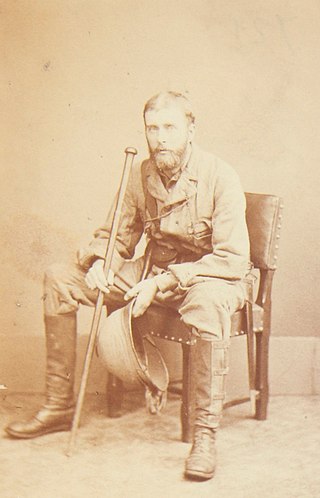
Major-General John Cecil Russell (1839–1909) was a British cavalry officer. After a brief service with the Oxford University Rifle Volunteer Corps Russell purchased a commission in the 11th Light Dragoons in 1860. He transferred to the 10th Light Dragoons and rose to the rank of captain by purchase before transferring to the 12th Lancers in 1872. Russell served with Garnet Wolseley in the 1873–1874 Anglo-Ashanti War and was considered a member of the Wolseley ring of rising men. In 1875 he was appointed an Equerry in Waiting to Edward, Prince of Wales and became an Extra Equerry in 1878.























